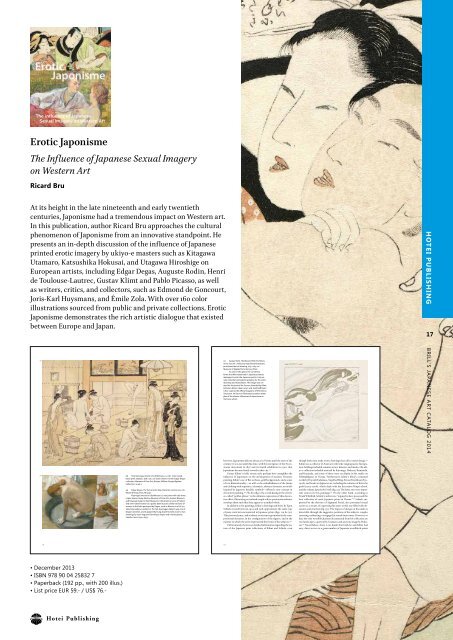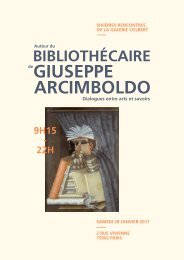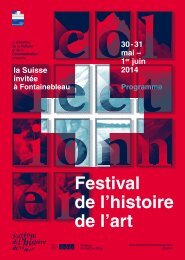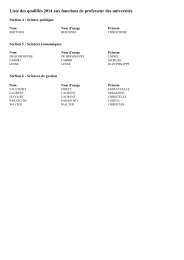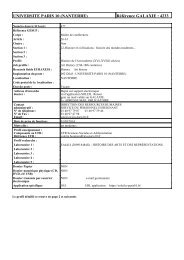japanese_art_catalog
japanese_art_catalog
japanese_art_catalog
Create successful ePaper yourself
Turn your PDF publications into a flip-book with our unique Google optimized e-Paper software.
78<br />
Erotic Japonisme<br />
The Influence of Japanese Sexual Imagery<br />
on Western Art<br />
Ricard Bru<br />
At its height in the late nineteenth and early twentieth<br />
centuries, Japonisme had a tremendous impact on Western <strong>art</strong>.<br />
In this publication, author Ricard Bru approaches the cultural<br />
phenomenon of Japonisme from an innovative standpoint. He<br />
presents an in-depth discussion of the influence of Japanese<br />
printed erotic imagery by ukiyo-e masters such as Kitagawa<br />
Utamaro, Katsushika Hokusai, and Utagawa Hiroshige on<br />
European <strong>art</strong>ists, including Edgar Degas, Auguste Rodin, Henri<br />
de Toulouse-Lautrec, Gustav Klimt and Pablo Picasso, as well<br />
as writers, critics, and collectors, such as Edmond de Goncourt,<br />
Joris-Karl Huysmans, and Émile Zola. With over 160 color<br />
illustrations sourced from public and private collections, Erotic<br />
Japonisme demonstrates the rich <strong>art</strong>istic dialogue that existed<br />
between Europe and Japan.<br />
HOTEI PUBLISHING<br />
17<br />
68<br />
127 Gustav Klimt. The Blood of Fish (Fischblut),<br />
in Ver Sacrum 1, February 1898. Book illustration,<br />
print based on ink drawing, 18.5 x 18.5 cm.<br />
Museum of Applied Arts, Vienna, ZII167.<br />
As seen in this piece, the curvilinear<br />
forms that Klimt observed in Japanese stencils<br />
(katagami) and in the Japanese prints in his private<br />
collection provided inspiration for his erotic<br />
drawings and illustrations. This image was created<br />
for the journal Ver Sacrum, founded by Klimt,<br />
Koloman Moser (1868–1905), and Josef Hoffmann<br />
(1870–1956) as the official magazine of the Vienna<br />
Secession. Ver Sacrum illustrated countless examples<br />
of the diverse influences of Japonisme on<br />
Viennese <strong>art</strong>ists.<br />
BRILL’S JAPANESE ART CATALOG 2014<br />
however, Japonisme did not advance in Vienna until the turn of the<br />
though both men made erotic drawings that call to mind shunga. 250<br />
century: it was not until this time, with the emergence of the Seces-<br />
Klimt was a collector of Asian <strong>art</strong> with wide ranging tastes: his Japa-<br />
sionist movement in 1897 and its fourth exhibition in 1900, that<br />
nese holdings included samurai armor, kimono, and masks. His uki-<br />
Japonisme became firmly rooted in that city. 247<br />
yo-e collection included material by Kiyonaga, Hokusai, Kuniyoshi,<br />
69<br />
68 Torii Kiyonaga. Interior of a Bathhouse, ca. 1787. Color woodblock<br />
print, diptych, 38.8 x 26.3 cm (each sheet). Former Edgar Degas<br />
collection. Museum of Fine Arts, Boston, William Sturgis Bigelow<br />
Collection, 30.46-7.<br />
Gustav Klimt’s richly ornate style perhaps best exemplifies the<br />
influence of Japonisme on the development of modern Viennese<br />
painting. Klimt’s use of flat surfaces, gold backgrounds, and a sense<br />
of two dimensionality—as well as the embellishment of the forms<br />
and clothing with repetitive, schematic, abstract elements, or motifs<br />
and Kunisada, and some of these were on display in his studio on<br />
Feldmühlgasse in Vienna. Furthermore, Klimt’s library contained<br />
works by Hayashi Tadamasa, Siegfried Bing, Ernest Fenollosa (1853–<br />
1908), and books on Japanese <strong>art</strong>, including the volumes of Kōrin-ha<br />
gashū (1903–1906), which dealt with the decorative Rinpa school,<br />
69 Edgar Degas. The Tub (Le tub), 1886. Pastel on card, 83 x 60 cm.<br />
inspired by Japanese heraldic symbols—offered a new concept in<br />
and the volume Japanische Erotik (fig. 52). The latter two were impor-<br />
Musée d’Orsay, Paris, RF4046.<br />
Kiyonaga’s Interior of a Bathhouse is a rare print with only three<br />
copies known today (Boston Museum of Fine Arts, Guimet Museum,<br />
and Kawasaki Isago no Sato Museum). It illustrates a scene of naked<br />
and semi-naked women at a public bath in poses similar to those of<br />
women in the bath portrayed by Degas, such as Woman in a Tub (ca.<br />
1883, Tate Gallery, London) or The Tub. Kiyonaga’s diptych was one of<br />
decorative painting. 248 The Kiss (fig. 128), a work dating to the <strong>art</strong>ist’s<br />
so-called “golden phase,” is the ultimate expression of this decorative<br />
effect, illustrating an isolated couple whose passionate embrace<br />
envelops them such that they appear as a unified whole.<br />
In addition to his paintings, Klimt’s drawings and those by Egon<br />
Schiele created between 1905 and 1918, approximate the same type<br />
tant sources for his paintings. 251 On the other hand, according to<br />
Frank Whitford, Schiele’s atelier was “reputed to have possessed the<br />
best collection of erotic Japanese prints in Vienna.” 252 Schiele, impressed<br />
by the theories of Sigmund Freud, also portrayed sexual<br />
scenes as a means of expressing his inner world, one filled with obsession<br />
and emotion (fig. 131). The impact of shunga on his nudes is<br />
Degas’s favorites, and it apparently hung above his bed, close to two<br />
drawings by Jean-Auguste-Dominique Ingres and a landscape by<br />
Camille Corot (1796–1875).<br />
of pure eroticism encountered in Japanese prints (figs. 129 & 130).<br />
This personal, pure, and aesthetic eroticism is grounded in the compositional<br />
elements, in the configuration of the figures, and in the<br />
detectable through the suggestive positions of his subjects: couples<br />
caressing, embracing, or engaged in sexual intercourse. However, to<br />
date the only woodblock prints documented from his collection are<br />
manner in which the <strong>art</strong>ist represented the forms of his subjects. 249<br />
two landscapes, a portrait by Utamaro, and an erotic image by Hoku-<br />
Unfortunately, there is no detailed information regarding the na-<br />
sai. 253 Nevertheless, there is no doubt that both he and Klimt had<br />
ture of the Japanese print collections of Klimt and Schiele, even<br />
easy, direct access to a great number of Japanese woodblock prints<br />
118<br />
Erotic_Japonisme_p001_192.indd 78 28-10-13 08:47<br />
Erotic_Japonisme_p001_192.indd 118 28-10-13 08:49<br />
• December 2013<br />
• ISBN 978 90 04 25832 7<br />
• Paperback (192 pp., with 200 illus.)<br />
• List price EUR 59.- / US$ 76.-


